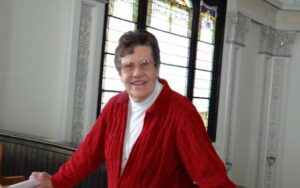Stewarding ancient trees and traditions

Our DD team of five gathered in Seattle last week for our first in-person meeting since January.
It was my first time in that part of our country. The mountain ranges, the cool lakes, the blackberries on demand, and the crisp (nearly mosquito free!) air made for a nourishing setting for us to breathe and pray together.
What struck me most were the trees.
We took a long walk in the arboretum and found ourselves swapping stories about the trees we have known: those we’ve visited on regular walks, that stood outside windows of our childhood homes, and those trees that inspire wonder, like Pando — the world’s largest tree, which began with a single seed and now contains over 40,000 “stems” spanning 106 acres.
We contemplated facts about trees, both benign and bewildering: how their presence in cities can reduce violence, how they cleanse our air and reduce our stress, how they care for each other and for us.
I like to think of our Church as a 2,000 year-old, old growth forest.
Old growth forests are precious; they should be protected and revered. While nature has a way of taking care of itself, we know that care for creation requires human co-responsibility and reciprocity.
For example, park rangers play a role in preserving forests for the future. They teach newcomers about forest ecosystems and each of our roles in maintaining them, and they monitor forests for invasive species that bring disease and threaten forest health.
These caretakers of our forests share a charism with many in our beloved Catholic Church. I think of those who teach the faith with clarity and kindness and guard against threats to it while evangelizing others to a way of life lit by the flame of Christ’s mission.
I think, too, with admiration about the prophetic activists who take up residence in the treetops to protect them from being cut down, and I imagine their close parallel with those in our church who boldly defend church teaching while being suspicious of proposed changes to the Church’s structure or practice.
There is an earnest and shared prayer here that goes much deeper than all divisions: a desire to faithfully steward this sacred, old growth forest for the next generation.
Deacons have been a part of our Church forest since its earliest days.
Over the centuries, many of us have forgotten the purpose of deacons as they faded from view. We’ve forgotten their names, we’ve forgotten that the church recognized the call of both men and women to share in the labor of this order, and we’ve forgotten that the community is authorized by the Holy Spirit to call forth as many deacons as are needed — as the third-century text, the Didascalia Apostolorum (Teaching of the Apostles) instructs, “The number of deacons should be in proportion to the number of the people in the congregation. There should be enough so that everyone is known and everyone looked after.”
And they are needed today. How many in our communities are not known or looked after?
Those tasked with stewarding our Church’s teaching and tradition, might think that ordaining women as deacons is akin to an invasive species, a kind of existential threat to the millennia old forest.
And yet…deep in the heart of the forest of our Church lies one of its greatest and oldest trees. Like Pando, whose age and breadth we are only beginning to grasp, she has been underestimated and misunderstood. Her name is Phoebe, and she’s ready to be remembered for the wonder that she is.
For centuries she was forgotten, her legacy unattended, her roots and branches hidden from view, left out of the lectionary, called “servant” rather than “deacon,” her feast day quietly removed from the liturgical calendar.
But she has not died; her trunk is two thousand years wide. She won’t be cut down.
Her seeds have dropped and the archeological, historic, theological record shimmers with evidence of her successors — standing in communion with those of St. Stephen and St. Lawrence — who in their day inspired courage with their faith and who accompanied pilgrims, visited the sick, led retreats, preached the Good News, stood as witness for women who suffered abuse. Though we have forgotten many of their names, they were called deacons in their own time, sent forth by their bishops to serve in and as Christ’s Church, present in the world.
Diaconal women operate today like networks of roots and mycelia that carry messages and nutrients throughout the soil. Though often unseen, without them the health of the forest would collapse.
Now it is our Pope’s task to discern — hopefully in consultation with the synod assembly he has called forth and will gather for such a task this October, and with the help of the Dicastery for the Doctrine of the Faith — is the diaconate for women and men an integral part of the old forest, or is it a threat from the outside? Is it vital for the health of the forest today, or should we cut it out?
Whatever our Pope decides, at the heart of our faith is a God who allowed himself to be nailed to a tree, so that we might turn away from the works of violence and division and instead follow Him, drawing near to the precious wood, to seek a way of peace.


